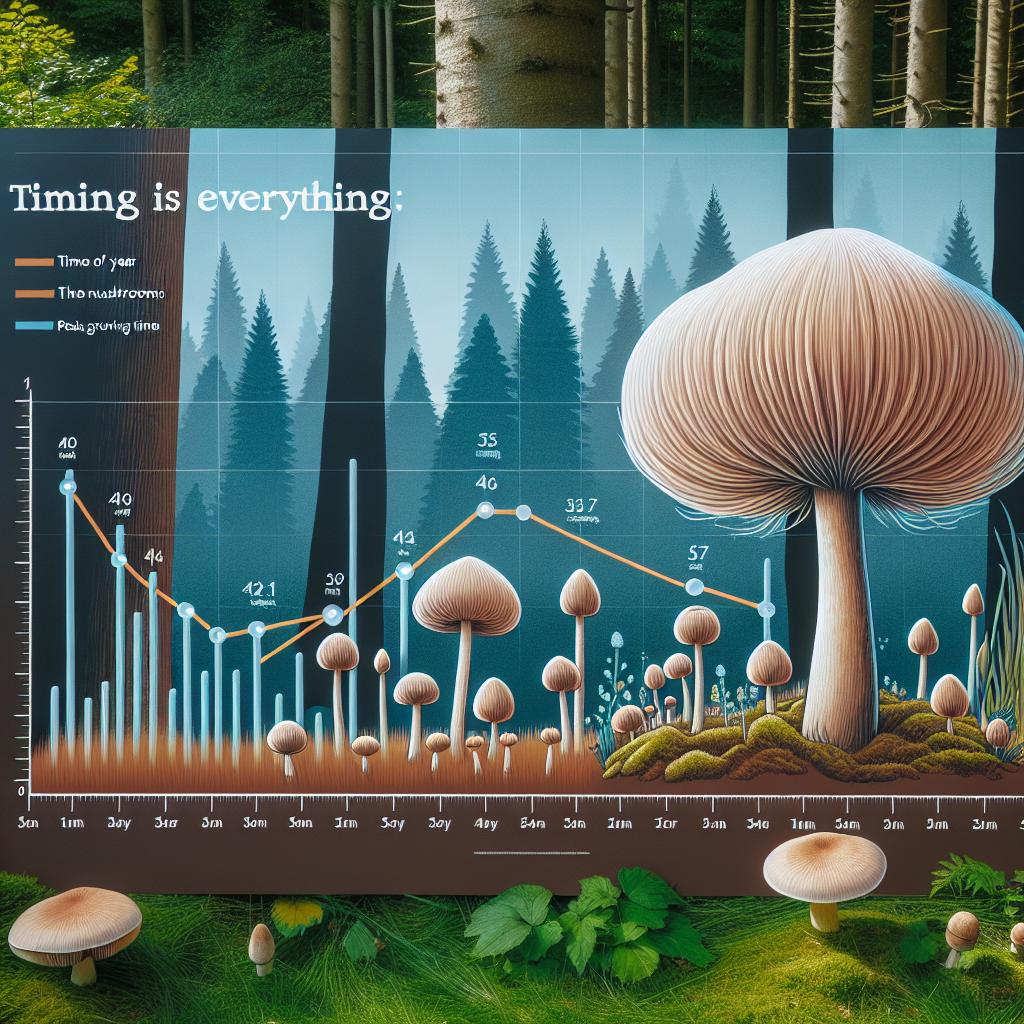
“Harvest Guide: When to Harvest Lion’s Mane Mushroom”
Imagine standing in a serene forest, the earthy aroma of damp soil mingling with the whispers of foliage overhead, as you stumble upon a most curious sight. There, clinging to an ancient hardwood tree, is a cascading waterfall of white: the Lion’s Mane Mushroom. This culinary jewel is not just a feast for the eyes, but a bounty for the body and mind, revered for its health benefits and delectable taste.
But hold on, forager extraordinaire, before you harvest this fungal wonder, it’s imperative to know the perfect time to pluck it from its wooden throne. Timing is everything—pick too soon, and you’ll miss out on its full potential; too late, and you may find your treasure has turned. That’s why we’ve crafted the ultimate guide to harvesting Lion’s Mane Mushroom.
In this article, we will unravel the mysteries of this mushroom’s peak perfection. We’ll into the signs and signals that Mother Nature provides to help you harvest at the height of flavor and nutritional value. So ready your baskets and sharpen your senses—it’s time to explore the art of harvesting Lion’s Mane Mushroom. Follow our guide, and you’ll not only capture the essence of the wild but also ensure every foray into the forest brings forth a bounty fit for a connoisseur’s kitchen.
Table of Contents
- Unlocking the Secrets of Lion’s Mane Mushroom Maturation
- Timing is Everything: Knowing When Lion’s Mane is at its Peak
- The Visual Cues of Perfectly Ripened Lion’s Mane
- The Touch Test: How to Physically Assess Lion’s Mane Readiness
- The Art of Harvesting Lion’s Mane: Techniques and Tools for Success
- Maximizing Potency: The Best Time of Day to Harvest Lion’s Mane
- From Harvest to Table: Storing Lion’s Mane for Optimal Freshness
- Navigating the Challenges of Overripe Lion’s Mane: What to Watch For
- Encouraging a Second Flush: Post-Harvest Tips for Lion’s Mane Growth
- Q&A
- In Summary
Unlocking the Secrets of Lion’s Mane Mushroom Maturation

Delving into the world of mycology, one quickly realizes that timing is the crux of harvesting the ever-mystical Lion’s Mane mushroom. As you watch these brain-boosting fungi emerge, their delicate spines appear like cascading waterfalls of ivory whispers. It’s not just an aesthetic transformation, but a clue to the readiness of this culinary and medicinal gem.
To the untrained eye, understanding the subtle hints of Lion’s Mane maturity can be as perplexing as interpreting an ancient scroll. This majestic fungus has a unique growth indicator – it’s all in the spines. Check for optimal length and density; when the strands are deep and thick, that’s nature’s signal. They should feel slightly moist, not dry, hinting that they’re bursting with benefits and ready to be plucked from their woody throne.
- Long, flowing spines signify full development
- Seek out a firm, slightly moist texture
- Harvest before spines begin to curl and dry for maximum potency
| Stage of Growth | Harvest Readiness Indicator |
|---|---|
| Initial Pinning | Too early – Let grow |
| Early Spine Development | Monitor daily |
| Spines Reach Full Length | Prime for harvest |
| Spine Tips Begin to Dry | Harvest immediately or quality declines |
When you’ve pinpointed that sweet spot in the maturation process, it’s as though the Lion’s Mane itself is inviting you to partake in its bounty. Slice close to the base to free the clusters, careful to leave mycelial blanket on the substrate undisturbed. This respectful harvesting fosters future growth, ensuring you can return time and again to the bountiful embrace of the Lion’s Mane.
Timing is Everything: Knowing When Lion’s Mane is at its Peak

Nature’s clock is not always ticking in tune with our schedules, and the Lion’s Mane mushroom is no exception. To ensure that you capture the full cerebral symphony of benefits this remarkable fungus has to offer, you’ll need to become a maestro of timing. Indeed, the difference between good and extraordinary can often come down to the harvest moment.
Here are a few tips to keep in mind:
- Monitor the growth. As the mushroom develops, it will transition from a tight, pin-like growth to a cascading waterfall of spiny tendrils. When these spines, or teeth, begin to elongate and hang, they are close to their most potent state.
- Assess the texture. A perfect Lion’s Mane has a consistency similar to that of a firm sea sponge. If it feels soft to the touch or appears overly saturated, it might be past its prime.
- Keep an eye on the color. The gleaming white hue is your green light. Once it begins to yellow or brown, the mushroom is giving you the signal that it’s time to harvest promptly.
But, how does this translate to a timeframe? The journey from spore to fruition is not an exact science, and environmental factors play a leading role. To give you a helping hand, the following table reflects a general timeline:
| Development Stage | Expected Timeframe | Visual Cues |
|---|---|---|
| Initial Growth | 1-2 weeks | Small, roundish knobs |
| Mid Growth | 2-4 weeks | Spines appear, mushroom expands |
| Harvest Window | 4-6 weeks | Long, dangling spines; firm texture; bright white color |
| Past Prime | 7+ weeks | Browning/yellowing, soft/soggy texture |
With a little observation and a lot of love, you’ll know just when your Lion’s Mane is trumpet-blaring, drum-rolling ready for harvest. The aim is to pluck it at its peak potency, which not only ensures a burst of flavor but also guarantees that you’re harnessing all the brain-boosting, nerve-nurturing goodness. So, get your baskets ready and your senses sharp – it’s almost showtime!
The Visual Cues of Perfectly Ripened Lion’s Mane

As you stroll through your homegrown mushroom sanctuary or scrutinize the aisles of your local farmer’s market, the sight of a ripe Lion’s Mane mushroom can feel almost mythical. Their shaggy, waterfall-like appearance is not only mesmerizing but also hints at the neurological treasures hidden within. Recognizing the optimal time to pluck these fungal gems is crucial for both their flavor profile and nutritional value.
Firstly, let’s talk about color. A prime Lion’s Mane mushroom features a pristine white to slightly cream hue. Watch for any discolorations – hints of yellow or brown may indicate aging beyond the peak harvest time. While still edible, older specimens may have a slightly more woody texture and less potent flavor. The goal is to harvest just when the mushroom’s spines, often resembling icicles or soft spurs, are fully elongated yet maintain their vibrant, snowy complexion.
The texture of these mushrooms is equally telling. A perfectly ripened Lion’s Mane is firm to the touch and springs back when gently squeezed. It’s the kind of quality that can’t be faked – when you press a finger into the side of the mushroom, an almost velvety resistance should be apparent. If the flesh feels mushy or brittle, you might be too late. Here’s a simple table to keep track of what to look for:
| Visual Cue | Indicator |
| Color | White to slightly cream |
| Spine Length | Fully elongated |
| Texture | Firm and springy |
| Discoloration | None (yellow/brown suggests overripe) |
Lastly, consider the aroma. As Lion’s Mane matures, it emits a subtle, earthy scent that’s reminiscent of the forest floor after rain. This fragrance should be fresh and inviting, without any hints of decay. Once harvested, use your nose to guide you through storage and preparation. An aromatic Lion’s Mane mushroom signals an unforgettable culinary experience that is both delicious and packed with beneficial properties. Trust these visual and sensory signs, and you’ll be sure to harvest Lion’s Mane mushrooms at the peak of perfection. Happy foraging!
The Touch Test: How to Physically Assess Lion’s Mane Readiness

Identifying the perfect moment to harvest Lion’s Mane mushrooms is as much an art as it is a science. There’s something of a tactile spell about it—you have to feel your way to the heart of readiness. The covetable firmness and springiness of a Lion’s Mane at its peak can often be determined with a gentle, but assured touch.
Begin by observing the mushroom’s exterior. The surface should be white and dense, free from any signs of dryness or yellowing which indicate over-maturity. Next, proceed with the palpation test. Gently press the outer spines. What you’re looking for is a slight resistance, a cushioned bounce back that whispers to your fingertips, “I’m ready.” Compare this sensation to a ripe avocado; not too hard, and not too squishy.
- Surface texture should feel slightly moist, not slimy or dry.
- Ideal spines are long and evenly hanging, suggesting the mushroom’s recent and rapid growth phase.
- Recovery from pressure is quick, maintaining the mushroom’s distinctive shape.
Notably, larger specimens may require a bit more discernment. Their size can sometimes lead to a more pronounced softness at the base, where the mushroom starts to demonstrate its readiness ahead of other parts. To ensure uniform texture and flavor, harvest these majestic fruits sooner rather than later.
| Characteristic | Unripe | Ripe | Overripe |
|---|---|---|---|
| Color | Pure white | White to cream | Yellowing |
| Texture | Firm | Firm with slight give | Too soft or spongy |
| Spine Length | Short | Long, hanging | Variable, may appear dry |
| Response to Touch | Hard, no give | Resilient, bounces back | Doesn’t hold shape well |
Remember, the touch test is your sensory guide through the mystical forest of Lion’s Mane cultivation. Trust your hands to lead you to the glory of a perfectly timed harvest—when the texture says ’tender’, and the structure sings ‘supple’, it’s time to gently twist and reap the fruits of your patience.
The Art of Harvesting Lion’s Mane: Techniques and Tools for Success

Gathering Lion’s Mane mushrooms is an almost magical experience, with their lush, cascading spines resembling a snowy mane. To ensure the most potent and flavorful harvest, there are techniques and tools that can elevate your foraging game to expert levels. Let’s explore these methods to yield a bountiful harvest, with a nod to the craft that it is.
Newcomers often wonder about the optimal timing for harvesting Lion’s Mane. The key is to observe the tendrils closely. When the edges start to turn slightly brown, and the spines have fully formed, it’s time to collect these woodland treasures. Early morning, just after the dew has lifted, is often the best time to harvest, as the mushrooms are plump with moisture and full of vitality.
- Sharp, clean scissors or a knife to avoid bruising the delicate flesh
- A soft brush or cloth for gently wiping away any woodland debris
- Basket or mesh bag to allow the mushrooms to breathe
Once your toolkit is ready, approach the harvest with a gentle hand. Cut the Lion’s Mane at the base, taking care not to crush its intricate structure. Work your way around the mushroom, examining for any pests or irregularities. Once picked, cradle it carefully in your basket; these beauties require space and air to maintain their splendor until they reach your kitchen.
| Harvesting Stage | Visibility | Texture | Flavor |
|---|---|---|---|
| Young | Smaller, denser clusters | Firm | Mild, delicate |
| Mature | Full, flowing spines | Soft | Rich, full-bodied |
Assure that you’re leaving enough behind to encourage regrowth. Sustainable harvesting ensures that you can return to the same spot in the following seasons for another successful foray. Your respect for nature’s cycle and your attention to the harvesting artistry will not only provide a personal sense of accomplishment but also guarantee the longevity of these incredible fungi for future generations to enjoy.
Maximizing Potency: The Best Time of Day to Harvest Lion’s Mane

Unlocking the full potential of your lion’s mane harvest pivots on one crucial aspect – timing. With the right pick, you invite a surge of earthy flavor and nutritive value into your kitchen. Pay heed to the whispers of nature, for the mushrooms themselves provide subtle clues about the peak moment for collection.
Early Morning Dew: The ideal harvest time is nestled in the gentle embrace of dawn. As the first rays of sunlight dapple the forest floor and the world awakens, your lion’s mane mushrooms are at their most potent. The overnight moisture envelops each delicate spore, enhancing its medicinal properties and flavor profile. This moisture not only contributes to the mushroom’s weight – a factor for those selling by the pound – but it also ensures a rich, succulent texture.
- Fresher taste and firmer texture
- Higher water content for better preservation
- Enhanced biological potency
However, for the data-driven cultivators, let’s translate intuition into figures. Here’s a snapshot in a simple table that captures the essence of timing your harvest:
| Time of Day | Advantages | Considerations |
|---|---|---|
| Early Morning (Dawn) | High moisture, maximum freshness | Perfect for immediate use or sale |
| Midday (Noon) | Better for drying/dehydrating | Reduced weight, less market value |
| Evening (Dusk) | Day’s growth cycle completes | May lose some freshness overnight |
By syncing your harvest with nature’s clock, not only do you stand to gain a superior product, but you also align with the serene rhythm of the forest. Take your basket, tread lightly, and let the tranquility of the morning guide you to the ideal harvest. Your senses, sharpened by the crisp air, will thank you – as will the savoring smiles of those who indulge in your lion’s mane bounty.
From Harvest to Table: Storing Lion’s Mane for Optimal Freshness

Once you’ve successfully identified the perfect timing for harvesting your lion’s mane mushrooms—ideally when the edges of the spines are still slightly curled inwards—you’ll want to ensure they’re stored properly to maintain their freshness and medicinal potency. Proper storage is not just about prolonging shelf life; it’s about preserving the sensory and nutritional qualities that make this mushroom a culinary and health favorite.
Immediate Post-Harvest Care: The first step in storage is handling your freshly picked lion’s mane with care. Minimize any bruising by gently placing them in a basket or container lined with a soft cloth. Before storing, avoid washing the mushrooms, as moisture can accelerate deterioration. Instead, lightly brush off any substrate or debris with a soft brush.
- Use a soft brush or cloth for cleaning
- Store in a breathable container
- Do not wash unless ready to consume
A Breath of Fresh Air: Lion’s mane mushrooms need to breathe, so opt for paper bags or cardboard boxes over plastic when looking for storage containers. If you’re planning on refrigerating, loosely wrap the mushrooms in paper towels before placing them in the bag to absorb any excess moisture, which destroys texture and flavor. Remember to store them in the main compartment of your fridge, where the temperature is most consistent.
| Storage Method | Shelf Life |
|---|---|
| Refrigerator (Paper Bag) | 5-7 Days |
| Refrigerator (Airtight Container) | Not Recommended |
| Freezer (Pre-cooked) | Up to 1 Month |
Longer-Term Solutions: If you’re not planning on using your lion’s mane mushrooms right away, consider drying them. Dried lion’s mane can be stored for months without significant loss of flavor or nutrients. Slice the mushrooms thinly for uniform drying, and use a food dehydrator or a low setting on your oven. Once fully dried, keep them in an airtight container in a cool, dark place, ensuring they’re fully sealed away from light and moisture.
By following these steps, your harvest will transition seamlessly from nature to nourishment. Every time you reach for your lion’s mane mushrooms, you’ll be greeted with prime freshness, whether you’re adding them to a scrumptious dish or brewing a healthy tea. Remember, proper storage is the final yet crucial stage in your mushroom foraging journey, locking in all the goodness until you’re ready to savor the taste and health benefits.
Navigating the Challenges of Overripe Lion’s Mane: What to Watch For

As an aficionado of the delectable Lion’s Mane mushroom, you’re likely aware of the culinary and health benefits that these unique fungi offer. But an often overlooked aspect is the delicate timing involved in their harvest. The transition from perfect ripeness to a state of being overripe can happen swiftly, and with it comes a host of pitfalls you’ll want to avoid.
Texture Troubles
One of the first signs that your Lion’s Mane has surpassed its prime is a shift in texture. While ideally, the mushroom should feel spongy and moist, an overripe one becomes overly soft or begins to dry out. This textural change can compromise both the flavor and the nutritional value, making it less appealing for your favorite dishes.
- Look for a firm yet yielding texture
- Avoid mushrooms that feel excessively soggy or brittle to the touch
Color Cues
Keep your eyes peeled for color alterations. Pristine Lion’s Mane boasts a pristine white or slight cream color. However, when overripe, the mushroom may exhibit discoloration, displaying yellowish or brownish hues. Such changes suggest the mushroom is past its best and may not provide the rich, savory taste it’s celebrated for.
| Ripeness Indicator | Desirable Qualities | Signs of Overripeness |
|---|---|---|
| Texture | Spongy, moist | Excessively soft, dry |
| Color | White to cream | Yellowing, brown spots |
| Smell | Earthy, fresh | Sour, ammonia-like |
Odor Observations
The distinct, earthy scent of a fresh Lion’s Mane is as inviting as its flavor. Should this aroma start to sour or take on an ammonia-like quality, it’s time to bid these mushrooms goodbye. The change in smell is a clear indication that the fungi are degrading, potentially leading to an unpleasant taste and diminished health benefits.
- A fresh, earthy smell indicates good quality
- Discard any Lion’s Mane emitting an off or chemical scent
Being mindful of these signs will ensure that your Lion’s Mane harvest is at its peak, promising the most delightful culinary experiences and healthful advantages. It’s a delicate balance, but one that’s easily mastered with a bit of attention and care. Savor the harvest at its best and enjoy the fruits, or rather, fungi, of your labor!
Encouraging a Second Flush: Post-Harvest Tips for Lion’s Mane Growth

Once you’ve experienced the joy of harvesting your first crop of Lion’s Mane mushrooms, it’s only natural to want more. Fortunately, with a bit of care, you can encourage your Lion’s Mane to produce a second flush, boosting your overall yield. Understanding the mushroom’s growth cycle is key to success.
First things first, hydration is crucial. After your initial harvest, your substrate—now devoid of the precious fungi—will need a little TLC to bounce back. Soak the substrate thoroughly, ensuring it is uniformly moistened but not waterlogged. This mimics the natural condition after rainfall, which is a perfect cue for mushrooms to grow again.
- Submerge the substrate in water for an hour.
- Allow for excess water to drain completely.
- Maintain consistent humidity levels after soaking.
Temperature and lighting also play significant roles in initiating a second flush. Keep the growing environment between 18-24°C (65-75°F), with indirect light and adequate air exchange to replicate conditions of the great outdoors. These parameters signal to the mycelium that conditions are ripe for producing another round of fruiting bodies.
| Parameter | Optimal Condition |
|---|---|
| Temperature | 18-24°C (65-75°F) |
| Humidity | 85-95% |
| Air Exchange | 3-6 times per hour |
| Indirect Light | Diffused/Natural |
Patience, however, is the substrate upon which all successful harvests grow. Resist the temptation to frequently check for new growth, as this can disrupt the environment’s stability. Give your Lion’s Mane the uninterrupted peace it needs to generate a bountiful second flush. Monitor and tweak environmental factors as needed, but most importantly, give the mycelium time to work its magic.
Q&A
**Q: What’s the prime time to harvest Lion’s Mane Mushrooms to get the best flavor and texture?**
A: The moment of harvest is key for savoring the delectable, seafood-like taste and tender texture of Lion’s Mane Mushrooms. Aim for the sweet spot when the spines of the mushroom—those toothy, icicle-like tendrils—are just long enough to impart a pleasant chewiness but haven’t become too tough. Typically, this is when the mushroom is at its full size, yet the edges of the spines are still soft and supple—usually a week or two after they first emerge.
**Q: Can weather conditions affect the timing of my Lion’s Mane Mushroom harvest?**
A: Absolutely! Like all gourmet fungi, Lion’s Mane is a bit of a diva when it comes to the perfect harvest conditions. Before your hands reach out to pluck this fabulous fungal treat, consider the weather. Humidity and temperature play starring roles in the development of these mushrooms. If it’s too dry or cold, they may slow their growth, leading you to extend your patience a bit longer. On the flip side, a stretch of warm, moist weather might accelerate their readiness. Keep an eagle eye on your mushrooms and the skies!
**Q: Is there a visual sign that a Lion’s Mane Mushroom is ripe for picking?**
A: Envision a ripe peach, just begging to be plucked from the branch. That’s your Lion’s Mane Mushroom calling out for harvest when it’s plump, white, and its spines are dangling elegantly. If the mushroom starts to yellow or brown, it’s slipping past prime time, tipping from tantalizingly tasty to a more bland, tougher version of its former glory. So, watch for the pristine white—it’s nature’s green light saying, “Pick me now!”
**Q: Could I harvest my Lion’s Mane Mushroom too early? Are there downsides to that?**
A: Patience, young grasshopper, is a virtue in the mushroom world. Harvest too early, and you’ll cheat yourself out of the full-bodied experience Lion’s Mane has to offer. Premature picking means less mass, as this mushroom bulks up significantly in the final days of growth. And let’s not forget taste and texture. The younger the mushroom, the less mature its flavor profile and the less impressive its meaty heft. Hold out for its peak performance, and reap the culinary rewards.
**Q: What happens if I wait too long to harvest my Lion’s Mane?**
A: It’s a thin line between perfectly ripened and past-their-prime Lion’s Mane Mushrooms. Wait too long, and you’re looking at a less appetizing scenario. Overripe mushrooms can develop a sour or bitter edge and a rather unpleasant, soggy texture—not to mention, they might deposit spores, which can make for a messy affair and potentially affect the growth of future flushes. Stay alert and harvest on time to maintain that gorgeous gourmet standard.
**Q: What’s my game plan if I can’t harvest my Lion’s Mane right when it’s ready?**
A: Life happens, and sometimes an ideal harvest time slips by. If you’re caught in a pinch, cool temperatures are your ally. Drop the temperature around your Lion’s Mane—as if you’re putting Mother Nature on pause. This can slow down the aging process and give you a brief window. However, don’t bank on this tactic for too long; nature always plays her hand. It’s best to harvest promptly to savor the most satisfying mushroom meal.
In Summary
As we draw the curtains on our journey through the enchanting world of lion’s mane mushrooms, bear in mind that the best harvest often comes to those who wait with wisdom and act with insight. Much like a seasoned forager who knows the whisper of the woods, you’re now equipped with the knowledge to recognize the perfect moment to pluck these brain-boosting treasures from their woody thrones.
Remember, timing is everything—the difference between good and great, between beneficial and optimal. With your newfound guide tucked under your arm like a trusty mushroom-picking basket, venture forth with confidence towards your harvest. Trust your senses, embrace the patience of a silent forest, and soon, you’ll be rewarded with lion’s mane mushrooms at their peak, ready to enhance your health and titillate your taste buds.
Don’t let this be merely another read; let it be your call to action. Transform your curiosity into a culinary conquest, your interest into an irresistible urge to interact with nature’s gifts. As autumn’s golden hues start painting the landscapes, let the lion’s mane mushroom inspire you to a bountiful harvest.
Take the leap, for as the forests await, so does your best harvest yet. Happy foraging!

























